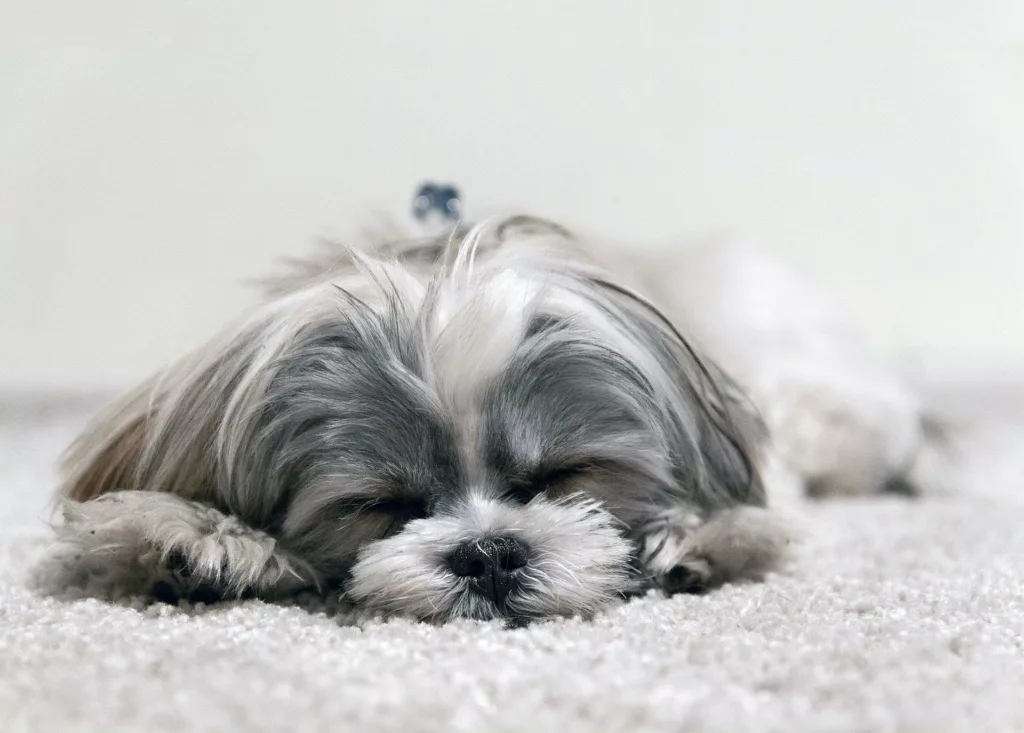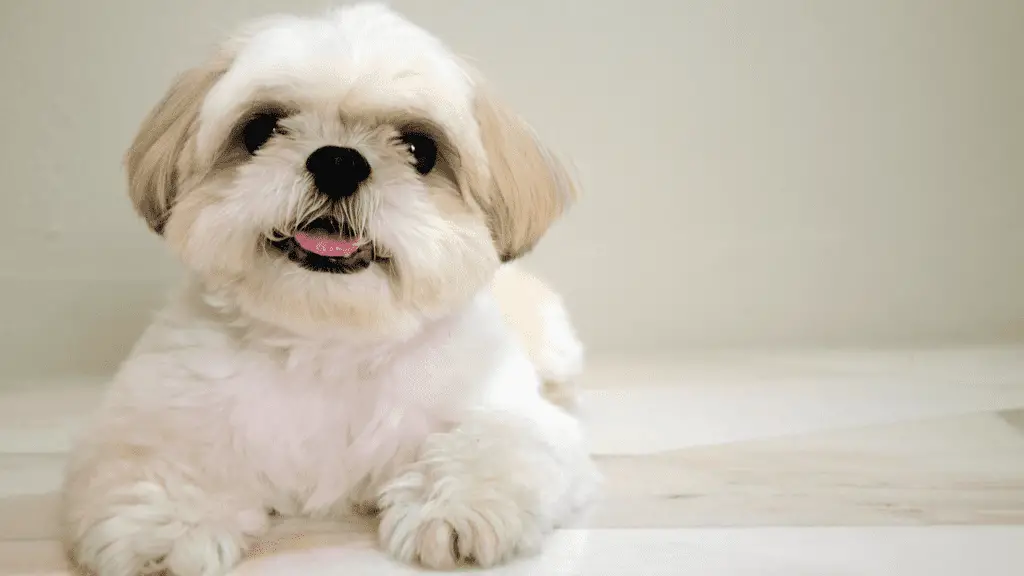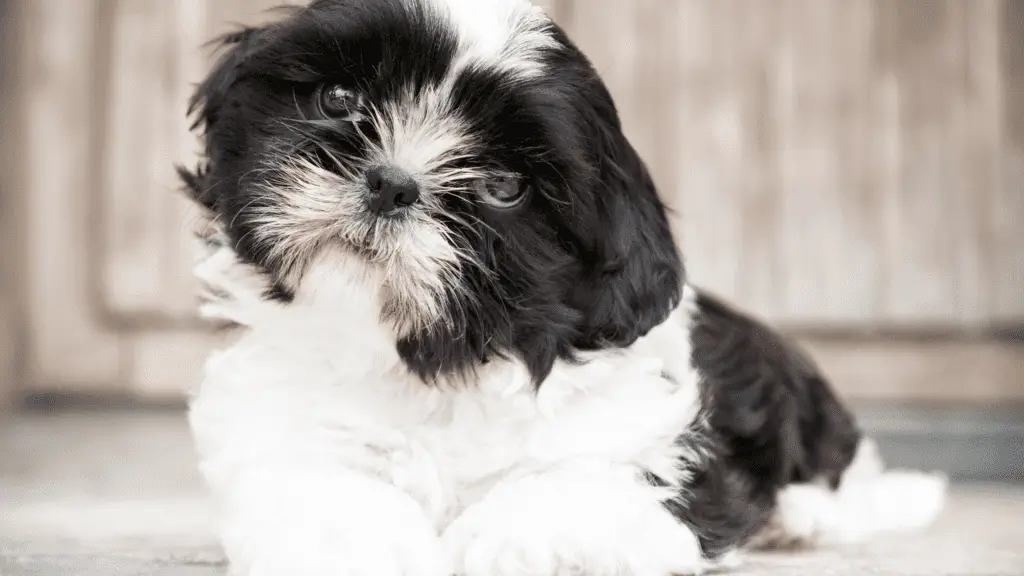
Breathing problems occur in most Shih Tzu dogs, and they can get cured by treatments. But first, you must figure out what problem they are facing from which the breathing problem has occurred.
What could the problems be? Here I’m listing some issues and treatments for Shih Tzu breathing problems. Most of the shih tzu face stenotic nares. It is the common cause of breathing issues.
Let’s dive into the article to learn more about the causes, treatments, and medications for Shih Tzu breathing problems!
Brachycephalic Airway Syndrome:
The brachycephalic is given to breeds like Shih Tzu that have breathing problems related to their bodies. It’s a general term that incorporates four health issues. That includes stenotic nares, elongated soft palate, collapsed larynx, and trachea issues. The Shih Tzu facing brachycephalic syndrome also has a long soft palate and stenotic nares.
The common brachycephalic airway syndrome has the following symptoms:
- Breathing difficulties
- Panting
- Trouble eating
- Noisy breathe
- Coughing
- Cyanosis
Elongated Soft Palate:
What Is It?
The soft palate is the beat of the skin at the back of the throat, as brachycephalic breeds have short palates placed within squeezed areas. It will block the ingress to the windpipe or trachea. This boosts airway resistance, and breathing problems occur.
All Shih Tzu has elongated soft palates. It has three ranges. The first one is slight, which means no symptoms will occur. The second one is moderate, which will show some signs. And the last one is severe and ruins the quality of the dog’s being.
Shih Tzu shall determine breathing issues for this as with average and severe elongated palates; symptoms are seen when getting young and are diagnosed in the 3-year-old puppy.
Here are the symptoms of this problem:
- Babies may dribble milk from their noses.
- Excessive panting.
- Gagging.
- Snoring.
- Saliva in excess.
- Collapse fainting.
- Ligaments in the larynx may stretch in severe conditions.
How Is Shih Tzu Diagnosed?
In minor cases, the veterinarian will get the Shih Tzu’s mouth checked when he is awake. This judgment call can make the dog excited, and this can cause breathing issues as well.
The vet may check the following:
- Complete blood count.
- Blood concentration for checking pH and CO2 concentration.
- X-rays for narrowed trachea.
Treatment:
Now you know the cause of the breathing issue in your Shih Tzu. You have to get the treatment done for them. Here are the following treatments for your Shih Tzu:
Non-Surgical:
In minor cases, if you make some changes, it will make your Shih Tzu breathe better. It compromises lessening the dog’s play in hot weather, avoiding overexcitement, and motivating different sleeping postures by having pillows and beds.
In significant cases where hinder is caused, you need to get cured by surgery to save your dog’s life. And you must keep in mind this situation worsens the dog’s growth. With time ligaments may stretch in the larynx and collapse.
Surgical:
Surgery includes the shortening of the palates. Veterinarians recommend this when your Shih Tzu reaches the age of 1 year old. It happens when the palate may increase when your puppy is getting into mature age. If you do it too early, you must do another procedure later.
Sometimes vets recommend removing dogs’ tonsils and palates. Opting for laser surgery is the best technique to lessen the palate.
It gets disinfected when cuts decrease the bleeding and swelling and shorten recovery time.
You must give them soft food when their healing period is going on. It may include rice, minced chicken, eggs, oatmeal, etc. you can also alleviate the food in warm liquid, gravy, or broth. Healing time depends, but the given time is 2-3 months

Stenotic Nares:
What Are Stenotic Nares?
Doctors use this term and its squeezed nostrils. It is caused by the inheritance of defacement of cartilage in the nostrils. The nostrils are too narrow. The narrow nostrils can make your Shih Tzu breathe with difficulty. Most Shih Tzu have stenotic nares.
Maybe stenotic nares are present at the time of birth but don’t appear until your dog reaches a mature age. Surgery is the only fair treatment.
Signs:
- Rowdy or amusic breathing when Shih Tzu breathes in mostly.
- Provincialism for exercise.
- A lack of oxygen and blue gums is called cyanosis.
- Shih Tzu faints in extreme cases.
How Is This Determined?
Vets recognize stenotic nares by simply looking at the nostrils opening.
Though several other issues include soft palate or collapsed trachea, they are less evident or need light.
Treatment:
The investigation shows stenotic nares need surgical correction for nasal discharge, but in some cases, they can get cured without surgery. Here are the following treatments for stenotic nares:
Non-Surgical:
In minor cases, some changes can:
- Immediately discontinue the collar. Your dog can never wear a collar out again on a leash. A harness will be used whenever Shih Tzu is on a leash.
- You must let Overexcitement low and offer playing activities in a way.
- Weight loss, however, it’s not common in the Shih Tzu breed. You must help him lose weight, as being overweight can cause problems.
Surgical Treatment:
The surgical treatment for this is opening the nostrils by removing a small piece of wall. It’s done through a scalpel or a laser.
- The disagreement for the delay in surgery: Vets not breed-specific may want to have surgery when it’s diagnosed. Most Shih Tzu have stenotic nares during teething time. As the dog grows, the nostrils may widen, and the inhaling problem has resolved. However, if the case is minor, you must tell the vet that he needs to wait until the teething time.
- The argument for surgery performed quickly: stenotic nares may trouble Shih Tzu in breathing. With time the larynx of your dog will become weak. In severe cases, the larynx may collapse and start breathing issues.
Collapsed Trachea:
What Is It?
The trachea is surrounded by rings that help the neck to get stretched. If the ring collapses inwards and obstructs breathing time, the trachea collapses. This situation is painful and difficult and usually happens with puppies.
Weak tracheal rings are genetic. A collapsed trachea can happen at any time, but the specific time is when the pressure and stress are placed on the neck. Its obtained form is connected to chronic respiratory issues and causes heart disease and Cushing disease.
This condition can develop at any stage, but the primary time for collapsing trachea is six years old.
Signs:
- A distinguishing cough. They are also referred to as honking noses. It is the most common sign of trouble causing breathing.
- Noisy breathing.
- Gagging.
- Trouble catching breath.
- Intolerance for exercise.
- Low oxygen levels.
- Collapse, fainting.
How Is This Diagnosed?
The veterinarian will detect it simply by honking cough. For further confirmation, x-rays need to get done. In most cases, collapsed trachea won’t be seen, but a dog will be treated for it. You can also ask for a fluoroscopy to check the dog’s collapsed trachea.
Treatment:
Non-surgical:
70% of dogs respond well to non-surgical treatments. All of these choices must be explored as surgery is drastic. It includes the following:
- It would help if you discontinued the collar immediately. A dog never wears a collar again, and a harness is used on the leash.
- Limited exposure to cold air. You must limit your dog’s outdoor activity when the temperature is below freezing.
- You must casually limit excitement and fun activities.
- It would help if you avoided exercise during hot weather. Activity in heavy weather can lead to breathing problems and a collapsed trachea.
- Weight loss: this is not in the Shih Tzu breed, but if your dog is overweight, help them lose weight to overcome breathing problems.
Medications:
- Coughing suppressants.
- NSAIDS. Such medicines can help with suffering and swelling.
- Corticosteroids. It includes prednisone to lessen pain and swelling. You must give it via a tool that is an inhaler. You can provide it for a short time to reduce any harmful side effects. In the short term, the dog may lose his appetite.

Breathing Spasms:
What Is It?
The breathing spasm is common in Shih Tzu as well as brachycephalic breeds. When a dog sneezes, the air rushes out, and the air goes in. As Shih Tzu has stenotic nares, this can make spasms more pronounced. It’s tricky to see and hear. Also, it makes the dog anxious, and reversing sneezing is not detrimental to a dog.
Signs:
Suddenly your dog is going to start to sound loud and quickly inhale. It’s rhythmic, like hiccups. It can be mistaken for the honking noise of collapsed windpipe, and consecutive snorting sounds occur with reverse sneezing. In this situation, a dog may stretch its neck and spread its elbow as if it wants to cough.
It’s not for a long time but short. You can expect to breathe as soon as it’s done, and the dog will behave normally. This process is repetitive and can happen anytime.
Triggers:
Some of the triggers include breathing in the frigid air, having a hurry of excitement, respiring hard due to physical activity, wearing a collar that is too tight, and living with airborne irritants.
Treatment:
Getting out of the issues involved with brachycephalic airway syndrome that reverses sneezing is essential. If your Shih Tzu faces breathing spasms, make a clip and show it to the veterinarian.
If this is reverse sneezing, here are some things that may stop these:
- You can place your hand on the nose and mouth for 15-20 seconds. Reverse sneezing releases excessive carbon dioxide. So this will store it to regular stages.
- Place a little amount of peanut butter on the nose of your dog. It will help your dog stick his tongue out, relaxing them and stopping reverse sneezing.
- Massage your dog’s throat downwards, which relaxes the throat and stops reverse sneezing.
- Offer your Shih Tzu a small snack and encourage them to eat. Sometimes if you interrupt reverse sneezing, it stops.
Allergies:
The allergies cause a dog’s wheeze and breath issues. Other reasons include rashes on the skin, itchy skin, and watery eyes. Some Shih Tzu may face coat issues as well as a runny nose. As it’s a huge subject, if you wonder if your dog is facing this, you may get it checked by a vet.
Breathe Better Tips For Shih Tzu:
As I have covered all the significant issues in breathing problems, there are some minor cases. This is for sure frustrating for the owners that they are told their dog is average, but their Shih Tzu faces problems in breathing and doesn’t look normal.
There are some tricks you can follow to make your Shih Tzu breathe better:
Avoid Overheating:
You must limit your dog’s working out during hot weather. As daily routine is essential for maintaining better health, you can adjust the summer walking time in the early morning or one hour before sunset. These are the most incredible times of the day. Bring a water bottle and stay in the shade with your dog.
Keep Moisture In The Air:
For some Shih Tzu breathing in dry weather is brutal. You can use humidifiers for this situation. If you cannot set them in your whole house, you can select the humidifiers near your dog’s sleep to make their nighttime breathing peaceful.
Position In Which Shih Tzu Rests:
The dog must have a mattress in which your dog doesn’t sink and sleeps peacefully. Moreover, placing a pillow under his head can help his neck elongate, and he can breathe better at night.
Problems When Over-Excited:
It would help if you made him relaxed before he reached a point where his breathing gets affected. It includes short breaks from plays and interval introductions of new areas if a Shih Tzu responds to a trigger.
Problems With Collars:
If the collar is too narrow, it will narrow the neck and cause respiring problems. Collars must be so loose that your two fingers can be placed under them. If a leash is connected to a collar, it will stress your dog’s neck. It can cause problems in breathing as well as breakage of the tracheal.
Final Thought
I have summarized the causes, treatments, and medications for the Shih Tzu breathing problems. The breathing problem is worrying but can be resolved immediately. Some treatments require surgeries, but others can get cured with medications and treatments. I hope this guide was helpful to you. Are there any queries? Drop a comment below. Happy reading!


